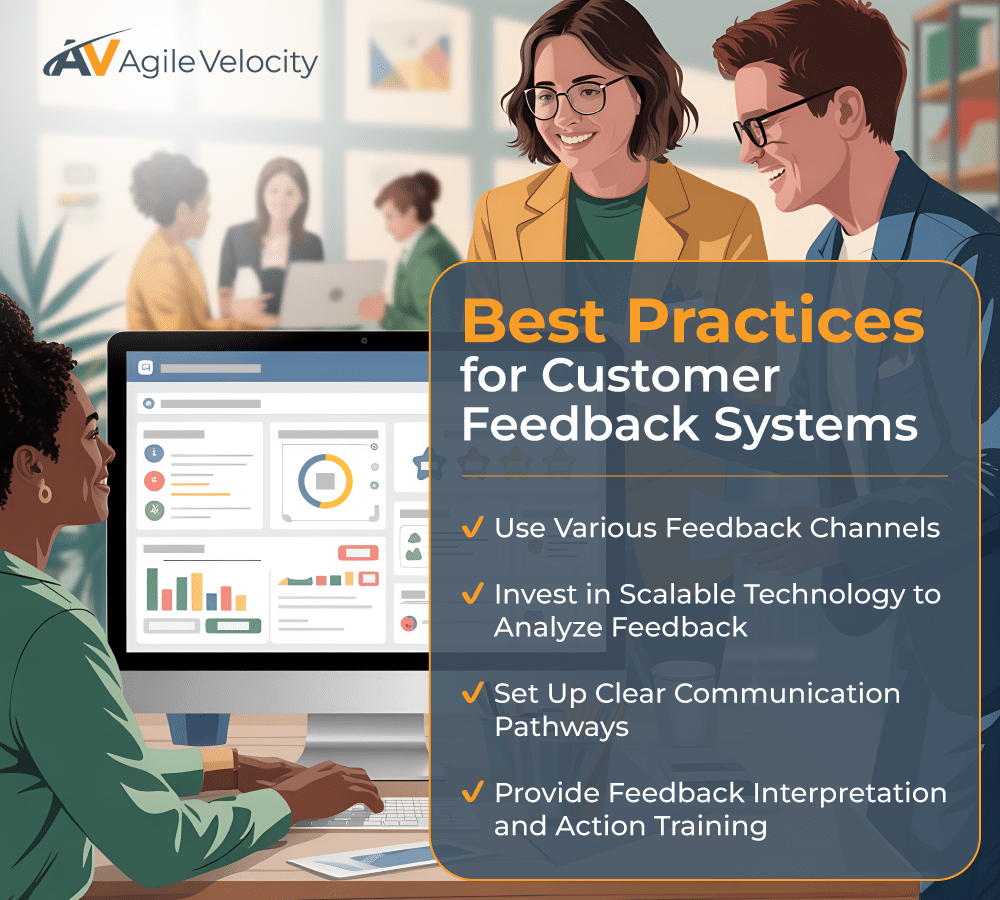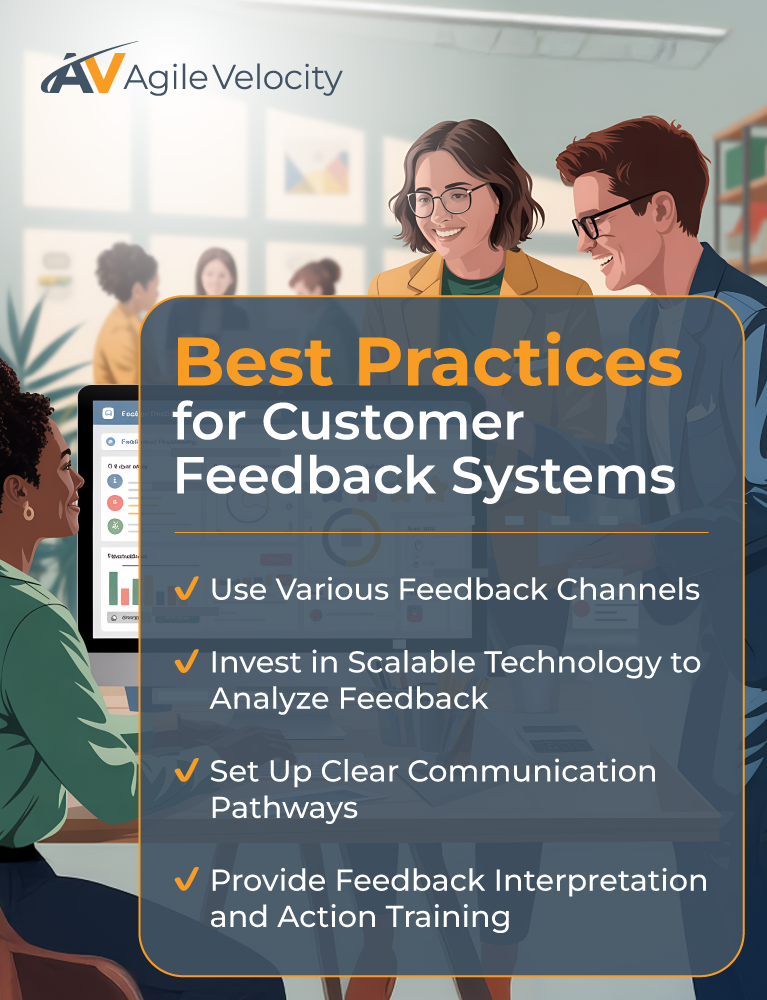Customer feedback is an invaluable resource for continuously improving your products, services, and processes. For many organizations, internal metrics take center stage, while customer insights remain overlooked. Effective quality management thrives when customer feedback becomes a core element, providing actionable insights that elevate quality standards. When combined with Agile, customer feedback fuels iterative progress, and fast adaptation, aligning teams with evolving customer needs.
In this article, we explore why customer feedback is essential for modern quality management, how Agile Transformation amplifies feedback loops, and how tools like Path to Agility® Navigator can turn customer input into measurable improvements. Whether you’re refining internal processes or striving to deliver exceptional customer experiences, integrating feedback at every level is the key to success.
The Role of Customer Feedback in Quality Management
Customer feedback is a fundamental pillar of quality management, offering a direct window into users’ experiences and challenges. While internal metrics gauge success, customer insights reveal the true measure of quality by showing what needs improvement and where additional value can be delivered. According to Harvard Business Review, capturing user perspectives reveals hidden opportunities for improvement.
Elevating Quality Beyond Metrics
Internal metrics provide a quantitative view, but they often miss the underlying reasons behind user satisfaction or dissatisfaction. Listening to your customers helps uncover issues such as missing features or cumbersome user experiences. This insight enables improvements that resonate directly with end users, beyond what traditional KPIs can capture.
Driving Actionable Improvements
Utilizing user Feedback for continuous improvement offers actionable guidance. Comments and suggestions often highlight specific areas needing attention, whether it’s fixing bugs, enhancing features, or introducing new solutions. Prioritizing customer feedback creates a dynamic cycle of improvement, transforming quality management into an ongoing process.
Building Trust Through Responsiveness
Responding to customer feedback shows that you value customer feedback, building trust and loyalty. When customers see their concerns addressed, they are more likely to continue using your product and advocate on your behalf. This responsiveness fosters long-term relationships and drives repeat business.
A Foundation for Continuous Improvement
Every piece of customer insight creates an opportunity to evolve. By making feedback collection a routine part of your processes, you embed a culture of continuous learning and progress. This iterative approach ensures that quality management remains a core organizational practice, echoing Toyota’s approach to continuous learning.
Why Customer Feedback Drives Higher Quality

Customer feedback elevates the quality of your offerings by providing real-world insights. When organizations listen to their users, they can align their products and services more closely with actual needs. Integrating Lean Portfolio Management can also help teams align improvements with strategic goals, ensuring each iteration targets real user requirements.
Aligning Solutions with Customer Expectations
Robust feedback channels reveal what customers value and what frustrates them. For instance, if users find a feature difficult to use, addressing that issue enhances the overall experience and better aligns offerings with customer expectations.
Preventing Rework and Reducing Defects
Real-life usage uncovers issues that internal tests might miss. For example, Southwest Airlines’ success story highlights how real-life usage uncovered problems that internal tests might overlook. Integrating customer insights into Agile workflows allows teams to fix issues early, reducing rework and minimizing costly last-minute changes.
Sparking Innovation
Feedback not only highlights problems but also surfaces new ideas. Customer suggestions often inspire features that differentiate your product. By leveraging these insights, organizations can drive innovation and stay ahead of the competition.
Sustaining Quality Through Accountability
Consistent customer feedback keeps teams focused on satisfaction. Regularly evaluating and acting on user input establishes a clear process for continuous improvement and reinforces a commitment to quality.
Overcoming Challenges in Feedback-Driven Quality Management
Despite its benefits, managing customer feedback can present challenges. Large volumes of input, ambiguous comments, and resource constraints can hinder progress.
Resource constraints can impede progress, but having help in onboarding the right candidates for these important roles can help address skill shortages and keep feedback channels active. Additionally, adopting a change management approach can ensure alignment and readiness across teams, fostering a culture where continuous improvement thrives. Transparent communication about priorities helps manage expectations and encourages broad support for a feedback-driven process.
Agile Transformation and Its Connection to Feedback
Agile Transformation is a shift toward flexibility, responsiveness, and continuous improvement. Embedding regular customer feedback at the heart of Agile practices creates a dynamic system where insights lead to immediate action.
Shorter Cycles for Faster Action
Agile enables teams to gather and integrate feedback quickly through iterative increments. Releasing new features in short cycles allows teams to evaluate real-world feedback and adjust accordingly, ensuring that every improvement moves closer to customer value.
Encouraging Transparent Communication
Agile practices emphasize open communication. Sprint Reviews, Daily Scrum, and Retrospectives offer regular opportunities for teams to discuss customer insights and adjust course, ensuring that feedback is always part of the conversation.
Breaking Down Silos to Amplify Feedback
Agile Transformation promotes cross-functional collaboration. Integrating feedback across departments ensures that solutions are developed holistically, addressing customer needsfrom multiple angles and fostering alignment among all teams.
Creating a Feedback-Driven Culture
When leadership champions customer feedback, it becomes part of the organizational DNA. This cultural shift not only improves processes but also inspires proactive innovations based on real user needs.
Leveraging Feedback Through Agile Frameworks
Agile frameworks such as Scrum, Kanban, and Scaled Agile Framework® (SAFe®) naturally incorporate feedback loops, making them ideal for embedding customer insights into daily operations. Similarly, frameworks such as Large-Scale Scrum (LeSS) or Disciplined Agile® (DA™) also rely on frequent feedback loops.
Scrum: Incorporating Feedback at Every Stage
Scrum provides structured events that encourage regular inspection and adaptation. During Sprint Planning, teams can prioritize user stories that address recent feedback, while Sprint Reviews and Retrospectives facilitate ongoing adjustments. This structured approach ensures that feedback becomes a driving force in both short-term iterations and long-term improvements.
Kanban: Driving Continuous Flow
Kanban emphasizes a continuous, efficient workflow. By visualizing customer feedback as actionable items on the Kanban Board, teams maintain a steady focus on the most pressing insights. Work In Progress (WIP) ensures that high-impact feedback is addressed without disrupting overall efficiency.
Scaled Agile Framework® (SAFe®): Scaling Feedback Across the Enterprise
For large organizations, SAFe scales feedback integration by linking customer insights to high-level planning and cross-team collaboration. Roles such as Product Managers and Product Owners ensure that customer input shapes backlog priorities, while regular PI sessions align team efforts with what customers value most.
Tools and Techniques for Effective Feedback Utilization
Effective feedback utilization requires both the right tools and well-defined processes. Centralizing input from surveys, customer feedback, and other channels helps ensure no valuable insight is lost. Whether through a CRM or a dedicated platform, consolidating feedback allows teams to spot patterns and drive improvements.
Streamlining Feedback Workflows
Convert customer insights into actionable tasks within your Agile workflows. Clear ownership and regular reviews ensure that each piece of feedback is addressed promptly. Techniques like thematic grouping simplify the prioritization process, ensuring that high-impact items are tackled first.
Leveraging Technology to Close the Loop
Feedback management software, project management platforms, and real-time collaboration tools help integrate feedback into everyday work. By linking these systems, organizations can reduce the gap between customer input and actionable outcomes, driving measurable improvements in quality management.
Path to Agility® Navigator, for example, is an invaluable software based on the Path to Agility approach for continuous improvement initiatives and Agile Transformation efforts. It helps your team visualize your organization’s progress and clearly shows where customer-driven improvements are needed. This tool transforms static feedback into a dynamic roadmap, enabling teams to monitor progress in real time and adjust strategies as required. Watch the video below to learn more about this invaluable tool.
Enhancing Organizational Agility for Quality Management
Quality management requires a shift toward a more agile, responsive organization. Embedding customer feedback across all levels amplifies its impact.
Empowering Teams to Drive Change
When employees feel empowered, they take ownership of customer feedback and drive continuous improvement. An environment where every team member can raise concerns and suggest solutions creates a more agile and responsive culture.
Facilitating Cross-Functional Collaboration
Breaking down silos is crucial. Coordinated efforts across departments ensure that customer feedback informs solutions comprehensively, delivering a more unified response that benefits the entire organization.
Building a Culture of Transparency
Regular feedback-sharing sessions and clear communication ensure that customer insights remain visible throughout the organization. This transparency builds trust and fosters a proactive approach to problem-solving.
Aligning Leadership with Feedback-Driven Agility
Leaders play a key role in modeling responsiveness to customer needs. When management actively champions feedback-driven initiatives, it reinforces the value of customer insights and drives organization-wide agility.
Continuous Improvement with Feedback Loops
Feedback loops create an ongoing cycle of collecting input, implementing changes, and evaluating results. Short, consistent feedback cycles help identify and address issues before they escalate, keeping the focus on continuous improvement.
Measuring Success and Tracking Progress
Once changes are implemented, track key outcomes to verify that the improvements are delivering the intended benefits. Metrics such as reduced support queries or higher satisfaction scores serve as concrete indicators of success.
Embedding Feedback into Daily Operations
Integrate customer insights into everyday Agile practices, whether as user stories in a backlog or tasks on a Kanban Board. Regularly reviewing feedback and assigning clear ownership ensures that customer input consistently drives progress.
Best Practices for Implementing Customer Feedback Systems
Implementing a robust feedback system requires planning and adherence to best practices. One key practice is the establishment of standardized channels for gathering feedback. Organizations should use a combination of surveys, direct interviews, and digital forms to capture diverse perspectives, ensuring no valuable insight is missed.
Investing in scalable technology solutions helps aggregate and analyze feedback efficiently. Real-time dashboards, automated reporting, and integrated workflows enable swift action to address customer needs.
Additionally, organizations benefit from setting up clear communication pathways that ensure user comments and suggestions do not get lost in the shuffle. A centralized platform or dedicated support channels can keep issues visible, allowing teams to track recurring themes and identify opportunities for rapid improvement. This structured approach helps transform unfiltered input into a steady, reliable flow of user insights.
Another essential practice is integrating feedback into your Agile processes. Incorporate user stories that reflect recent feedback into each Sprint Planning session. This approach allows you to respond promptly to emerging issues, making delivery more dynamic and responsive.
To truly capitalize on customer feedback, it is vital to analyze data in a way that translates insights into strategic action. By employing analytical methods to interpret feedback trends, organizations can make informed decisions about product enhancements, process optimizations, and future innovations. This data-driven decision making not only fine-tunes current operations but also lays the groundwork for enduring success. Educating staff on prioritizing improvement areas helps ensure that major concerns stand out, and frequent discussions about user feedback in cross-functional sessions promote holistic solutions.
How Agile Coaching Helps You Harness Customer Feedback

Customer feedback is the cornerstone of effective quality management, providing the actionable insights needed to enhance products, processes, and customer experiences. When combined with an Agile mindset organizations can create a continuous cycle of improvement. By incorporating shorter feedback cycles, prioritizing customer needs, and fostering cross-functional collaboration, you can consistently deliver higher-quality outcomes that meet evolving expectations.
Agile Coaching plays a pivotal role in ensuring that feedback is prioritized within work processes. With proper guidance, teams learn to regularly assess insights and tailor Agile ceremonies to incorporate customer input. Coaches also facilitate open discussions during Retrospectives, converting feedback into actionable tasks and reinforcing a mindset of ongoing growth. This supportive environment allows teams to confidently move from recognizing issues to implementing lasting improvements.
At Agile Velocity, we’re dedicated to helping organizations harness the power of feedback to drive long-term success. Reach out today to begin your journey toward greater efficiency, innovation, and customer satisfaction.





